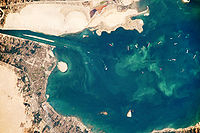
Photo from wikipedia
Abstract Soil salinity is a common problem among lands, which plays harmful effects on groundwater, leading to some problems on land use, use of water, and accordingly on human life.… Click to show full abstract
Abstract Soil salinity is a common problem among lands, which plays harmful effects on groundwater, leading to some problems on land use, use of water, and accordingly on human life. The present study was conducted to simulate soil salinity in the root and transition zones in ten years of simulation period and assume the impact of drain depth and irrigation scenarios on soil salinity and depth to water table. Thus, SaltMod was used with the Geo-Hydrological data collected from Dizaj-e Dowl area located in the northwest of the Urmia Lake. The results indicated that the leaching efficiency of 0.5 in the root zone and natural drain depth of 8.5 and 5.5 m/season were the best match with the observed data. Soil salinity in the root zone had a consistent trend both above and below the drain level rise from 8 dS/m during the first season to 55 dS/m in the second season. Based on the water table, an increase of 7.7 m occurred after 10 years of the simulation period. In addition, the drain depth of 1.2 m assumed in the pilot area appeared to be feasible. Based on the results, SaltMod can be used to predict soil salinity for a long-term analysis by assuming the effect of different scenarios of irrigation and drainage depth on soil salinity in various soil horizons.
Journal Title: CATENA
Year Published: 2019
Link to full text (if available)
Share on Social Media: Sign Up to like & get
recommendations!